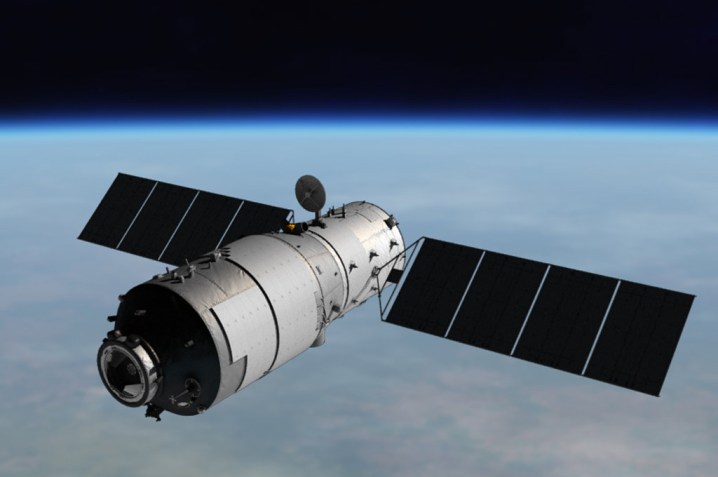The out-of-control Chinese “Heavenly Palace” will re-enter the Earth’s atmosphere tonight and meet a fiery end — or at least most of it will. Space agencies around the globe have been tracking the school-bus-sized space station as its orbit decays, and the most recent forecast from the Aerospace Corporation predicts it will begin to break up at 8:10 pm Eastern Time (0010 GMT Monday, April 2), plus or minus a couple hours.
“We know that Tiangong-1 is tumbling, or at least it was when Germany took [a] radar update, so the question is it still tumbling, and is the tumbling getting faster or slower,” Aerospace told Space.com in an update on Saturday. It’s currently at an altitude of 104 miles.
Space.com also has a handy satellite tracker if you want to get real-time updates on its position.
Harvard astrophysicist Jonathan McDowell tweeted “OK Tiangong-1 fans, now we’re cooking.”
OK Tiangong-1 fans, now we're cooking. The @SpaceTrackOrg TIP window is down to +- 3 hours, during which time Tiangong-1 makes 4 orbits of the Earth. We can start to narrow things down at last!
— Jonathan McDowell (@planet4589) April 1, 2018
The orbit of the “Heavenly Palace” means any debris will land in an area stretching from 43 degrees north to 43 degrees south, although the updated predictions rule out North America, India, Europe, and Australia.
Up to 10 percent of the space station could survive re-entry, but without details on its construction, Western analysts can’t say how much of the spacecraft will remain intact. “To make any sensible statement about what will survive, we’d need to know what’s inside,” said Stijn Lemmens of the ESA. “But the only ones who know what’s on board Tiangong-1, or even what it’s made of, are the Chinese space agency.” Although the original plan was for a controlled re-entry into the ocean, the on-board lab malfunctioned in March 2016 and Heavenly Palace has been a rogue spacecraft since.
Launched in 2011 in an effort to compete with the U.S. and Russia, the spacecraft was decommissioned in 2016, and China notified the United Nations that it would likely break apart and fall to Earth sometime in 2017 or 2018.
It’s unlikely that the remnants of the Tiangong-1 will land in a populated area, with most of the Earth covered by water and huge tracts of uninhabited land. However, chunks of debris as large as 60 pounds are expected to make it through re-entry and to the planet’s surface.
What should you do if pieces of the space station crash-land in your neighborhood? Don’t mess with it, says The Aerospace Corporation: “For your safety, do not touch any debris you may find on the ground nor inhale vapors it may emit.” That said, you should certainly let the Aerospace Corporation know if you see the aircraft’s reentry this spring.
At 10.4 meters long and nearly 8.75 tons, Tiangong-1 served as a test bed for a variety of critical systems, such as life support. It also docked with the Shenzhou-8, Shenzhou-9, and Shenzhou-10 spacecrafts and performed a variety of other tasks during its four-and-a-half-year lifespan, some two years longer than initially anticipated.
Tiangong-1 was replaced by Tiangong-2. The new station will house two Chinese astronauts for up to a month, with further tests on life support systems and “scientific research.” One of those tests is an atomic clock, which scientists want to use to determine if the effects of gravity increase the accuracy of the timepiece, according to news reports.
But even Tiagong-2 won’t stay in orbit very long. That station, too, will fall to Earth in an uncontrolled manner, likely soon before the final version of the station launches sometime in the 2020s.
Updated on April 1: Added latest re-entry information from the ESA and Aerospace.
Editors' Recommendations
- NASA is seeking help to crash the space station at the end of its life
- Space station’s new robotic arm springs to life
- Watch SpaceX’s Crew-4 astronauts arrive at new home in space
- Watch how space station astronauts get ready for bed
- Axiom-1 to depart from ISS today after extra days in space



